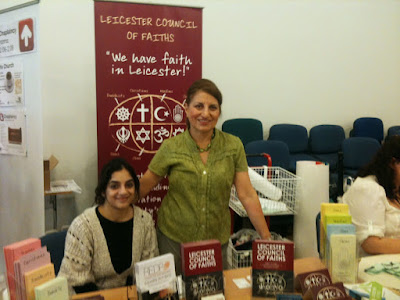Today is the second annual Sewa Day. Here's some information from the Sewa Day website. There's lots more of interest and inspiration to be found there.
Sewa is a universal concept, which involves performing an act of kindness without expectation of reward. It is performed selflessly and without ulterior motive.
As a concept, Sewa in embedded in Indian traditions, and is actively promoted by different cultures and faiths - as the core belief is the same - to sacrifice your time and resources for the benefit of others without wanting anything in return.
On Sewa Day, thousands of good-hearted people across the world come together to perform Sewa and experience the joy of giving in its truest sense. By participating in this collective endeavour, we hope that the seeds of Sewa are watered so that acts of kindness and public service are performed more often. Sewa Day is a catalyst in making this happen.
Previously, participating groups have organised Sewa Day volunteering projects in old people’s homes, homeless shelters, schools in disadvantaged areas, hospitals and hospices, country parks, conservation areas and city farms – all with an aim of making a positive difference to someone else’s happiness and prosperity. Join us this year to make our dream a reality.We’re all concerned about disadvantage, deprivation and ignorance. Sewa day provides an opportunity to do something positive that makes a meaningful difference to someone else’s quality of life.
We discourage all projects that involve fund-raising; as the purpose is to give your time. So, let’s focus on that.
It really doesn’t matter if you’re a pensioner or a young child, whether you’re physically able or not, or whether you black, brown or blue.
All that matters is that you commit to doing a good deed on Sewa Day, which takes place on Sunday, 25th September 2011.
Sewa UK is a secular, non-political UK registered charity.
While Leicester Council of Faiths is not, itself, participating in or promoting any particular activity for Sewa Day 2011, I couldn't let the occasion go by without reflecting on how selfless service is treated in the scripture or inspirational texts of our eight member faith communities.
In the extract from the Sewa Day website above, it states, "As a concept, Sewa in embedded in Indian traditions, and is actively promoted by different cultures and faiths - as the core belief is the same - to sacrifice your time and resources for the benefit of others without wanting anything in return." This does not suggest (indeed, it counters the suggestion) that such a concept and practice is the domain of the faiths, religions or philosophies of Indian origin alone. They can surely be said to be common to all religions, sometimes being expressed in more general terms as "The Golden Rule"). But whether it is called sewa, service, charity, caritas - or some other term - it is one of the core principles, central practices and essential virtues of the spiritual life. It may be expressed in a myriad forms and practices, but its presence enriches the world and its absence devalues religion itself.
Here are some quotations from each of our eight member faiths that I have found myself. No doubt you could come up with many more, faithful reader.
Bahá'í
"This is worship: to serve mankind and to minister to the needs of the people. Service is prayer." ('Abdu'l-Bahá)
Buddhist
"The greatest quality is seeking to serve others." (Atisha)
Christian
"Each of you should use whatever gift you have received to serve others, as faithful stewards of God’s grace in its various forms." (1 Peter 4:9-11)
Hindu
“Give. Give with faith. Do not give without faith. Give with sensitivity. Give with a feeling of abundance. Give with right understanding.” (Taittiriya Upanishad)
Jain
"In making a gift one gets over greed, which is a form of Himsa, and hence gifts made to the worthy recipients amount to a renunciation of Himsa (i.e., amount to observance of Ahimsa)." (Purusharthasiddhi-upaya)
Jewish
"He defends the cause of the fatherless and the widow, and loves the foreigner residing among you, giving them food and clothing." (Deuteronomy10:17-19)
Muslim
"Worship God, and join not aught with Him in worship. Be good to parents, and to kindred, and to orphans, and to the poor, and to a neighbour, whether kinsman or new-comer, and to a fellow traveller, and to the wayfarer, and to the slaves whom your right hands hold; verily, God loveth not the proud, the vain boaster" (Qur’án, 4:40)
Sikh
"A place in God's court can only be attained if we do service to others in this world." (Guru Granth Sahib)


















